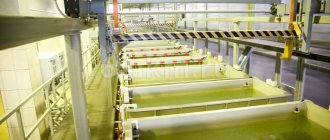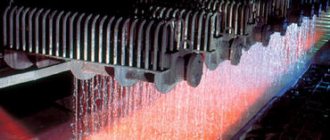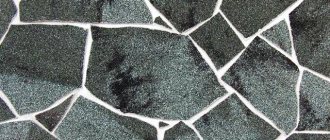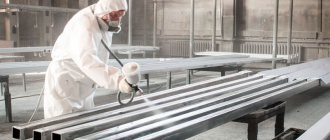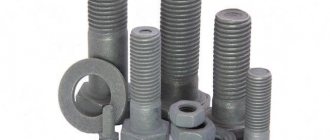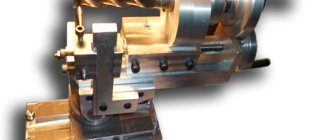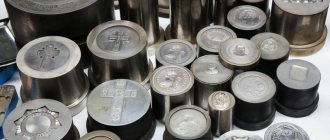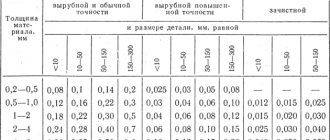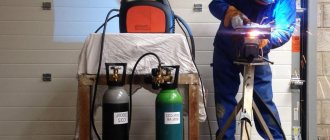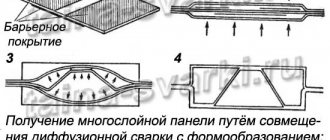Purpose of the galvanic method
Electroplating of metal on the surface is used to give them the properties of a specific material (silver, gold, nickel, etc.). Or if it is impossible to make an item from this material, and also if the price is unreasonably high.
For example, the application of chromium imparts hardness and anti-corrosion properties to plain steel. This technology was widely used to coat parts and mechanisms of machine tools. Chrome, in addition to being hard, gives a mirror-like shine and provides good protection against corrosion. Chrome is a hard but brittle metal, and it is not possible to manufacture parts and objects from it. Applying it to the surface by electroplating is a good alternative, as well as the opportunity to use the properties of chromium in everyday life.
The galvanizing process is carried out in special baths. An electrolyte containing salts of the metal that is deposited on the surface of the workpiece is poured into it. Compared to other methods, electroplating technology has advantages. When using, for example, a spray gun or other spraying devices (many organizations pass off this method of metallization as electroplating), it is impossible to achieve a perfectly even coating, high-quality adhesion and obtain the properties of metal on the surface. Usually, a non-conductive polymer layer is applied by spraying, in other words, paint, or a thin silver layer (for the reaction of a silver mirror, see the school curriculum), and on top is a transparent or colored varnish. The electroplating process makes it possible to obtain a uniform, dense, well-adhesive coating that has all the properties of the deposited metal.
Materials that cleaning chemicals cannot remove
There are some materials that chemicals cannot remove, or are difficult to remove, for the electroplating process. Here is a list of the most common of these materials:
- weld slag and other welding flux residues;
- splashing and splashing;
- burrs (may include excessively rough edges from flame cutting);
- mill coatings such as varnishes or varnishes found on some types of pipes;
- epoxy, vinyl and asphalt;
- sand and other impurities for castings;
- oil paints and markers;
- pencil markers;
- very heavy or thick deposits of wax or fat.
These materials must be removed from the surface before it is delivered to the galvanizing plant or in the case of domestic conditions.
Surface before and after cleaning and galvanizing
There are various generally accepted standards for abrasive blasting, hand cleaning and power tool cleaning that are effective in removing these materials. Abrasive blasting is usually necessary for castings to remove sand and other impurities from the casting process. Alternatively, a variety of products can be used that are compatible with the electroplating process to reduce the need for blasting or power tool cleaning. The use of uncoated electrodes avoids the problem of flux deposition during welding, which is harmful during the operation. Markers are available that easily dissolve in the baths used in the galvanizing process.
The essence of the technological process
Electroplating is used to produce thick technical and thin decorative layers of metal. The functions of electroplating are determined not by the layer that is applied to the surface, but by its characteristics: thickness, sublayer, preparation (etching, polishing).
The electroplating method is quite simple:
- The workpiece is carefully inspected for existing coatings and surface condition.
- Procedures for degreasing, etching and activating the surface of the part are carried out.
- The composition of the liquid electrolyte in which the product will be immersed is selected.
- Electrolyte is poured into a special bath to which one or two anodes are connected.
- A part connected to the cathode is lowered into it.
- An electric current is started.
- Under its influence, particles of metal salts are directed towards a negatively charged product.
- Metal is deposited on the entire surface of the product in a thin, uniform layer.
- After completion of the galvanic process, the supply of electric current is stopped, the product is removed, thoroughly washed and dried, and, if necessary, further processed.
Electroplating technology is simple, but requires special equipment and sufficient qualifications of performers.
The galvanic method is used to give mechanisms, contact groups or surfaces the properties of the applied metal. For example, the application of precious metals (gold, palladium, rhodium) to electrical contacts is used to impart chemical resistance, as well as maintain constant resistance. In this case, the species characteristics are not important. Of course, it is necessary to maintain the specified grain size of the coating, but this problem appears at metal deposit thicknesses of more than 20 microns. Thick galvanization gives high wear resistance and non-porous metals, which means the reaction properties of the base material can be ignored.
Technical Nickel electroplating coatings are made for units and items that experience constant mechanical stress. Nickel is a hard, inexpensive metal. It is applied to steel products that require corrosion protection.
Often there are lubricant coatings, the application of which does not so much take into account the chemical characteristics of the metal itself as it is necessary to ensure, for example, tight lapping of parts, but for some reason lubricants cannot be used. These are tin, lead, indium coatings. In these cases, the coating thickness ranges from 30 to 50 microns.
Our organization, 6 Micron LLC, provides services for the application of technical coatings to defense enterprises, enterprises in the space and aviation industries, and the electronics industry.
There are often cases when metals are applied only for decorative purposes or to add color (gold, silver, etc.), without requests for hardness or density.
Process Features
Electroplating, including at home, is very similar to electrolysis (where electricity is used to separate a chemical solution), which is the reverse procedure in which batteries produce electrical currents.
Electrolysis circuit
It is necessary to use the correct electrodes and electrolyte solution for electroplating at home, predetermining the chemical reaction or reactions that will occur when the electric current begins to act. The atoms that attach to the product come from the electrolyte. Therefore, if there is an electroplating process for copper plating, you need a copper electrolyte, and for gold plating, you need a gold-based electrolyte.
During electroplating, the master must make sure that the product to be used is completely clean. Otherwise, when atoms from the electrolyte arrive at it, they will not form a good bond, and the elements may simply precipitate. Typically, cleaning is accomplished by immersing the electrode in a strong acid or alkaline solution, or by (short) connecting the plating circuit in reverse. If the electrode is truly clean, the atoms from the metallization combine into a very strong crystalline structure.
Gilded items
Electroplating, done at home, involves passing an electric current through an electrolyte. This is done by dipping two terminals, called electrodes, into electrolyte and connecting them to a circuit with a battery or other power source. Electrodes and electrolyte are made from carefully selected elements or compounds. As electricity flows through the circuit, the electrolyte is broken down and some of the atoms of the material it contains are deposited in a thin layer on top of one of the electrodes. In this way, home electroplating is realized. All types of metals can be plated in this way, including gold, silver, tin, zinc, copper, cadmium, chromium, nickel, platinum and lead.
To achieve an even electroplating finish, the technician must first clean the surface of your metal object and prepare the necessary equipment. Dirt and oils on the surface may prevent the donor element from covering the surface. Start with degreasing, detergent (dish soap), and then scrub the metal with an abrasive acid cleaner to get a very clean surface.
Galvanic method
The galvanic coating method is used in the following industries:
- Treatment of products against corrosion;
- Coating of parts and assemblies of complex machines and equipment;
- Processing of costume jewelry and jewelry;
- Ensuring solderability and wettability of the surface of parts;
- Giving antioxidant and decorative properties to the surface (mainly precious coatings).
While large industrial electroplating baths are required in the field of mechanical engineering, automotive industry, and metal structures production, compact equipment is used in the production and electroplating of jewelry and contact groups.
Jewelry companies make up the number of regular clients of our organization. The production of jewelry from precious metals and jewelry alloys periodically requires the application of a protective or decorative layer of electroplating to the surface. For example, jewelry alloys coated with a layer of real gold increase in price several times, while the cost of jewelry is relatively low. Owners of big names often take advantage of this, releasing collections of jewelry in gold or rhodium plated, despite the fact that the price of plated earrings is often comparable to the price of earrings made of pure gold.
The requirements for electrolytes and the result of processing at a jewelry factory are very high: it is necessary to maintain the class of the surface, the shade of the applied metal, and the thickness of its application. Typically, for jewelry and decorative purposes, the application thickness does not exceed 2 micrometers, so the listed requirements are feasible.
In the field of applying decorative coatings to jewelry, 6 Micron LLC cooperates with factories from the Moscow region, St. Petersburg, Kostroma, Kaliningrad region, as well as other constituent entities of the Russian Federation.
Our organization has a broad area of activity - electroplating on souvenirs, gifts, and household items. Giving a souvenir plated with gold or silver, electroplating an antique watch, restoring it on antique dishes - all these are our daily services. For example, a builder is given a gold helmet as a gift, and a hockey player is given a gold puck. The list of ideas here is limited only by human imagination. Any item can be treated with galvanic gold to get an original souvenir or memorable gift. Gilding is performed only with 999 purity gold. Electroplating is the only way to apply real gold or silver.
Also, clients turn to us in order to obtain a beautiful chemical-resistant coating for plumbing fixtures - faucets, buttons, levers, valves.
Over the past 5 years, electroplating has also often been used for gilding jewelry made from real wood leaves, flowers, and twigs. Recently, this idea has become popular and requests for such work are coming in more and more often.
Preliminary inspection of the part
Before starting work, the expert will conduct a preliminary examination, assessing the size, shape, geometry of the product, the presence of decorative elements, engraving, and relief details. The composition of the metal is also important.
Based on the information obtained, the composition of the electrolyte is selected. The exact thickness of the galvanic layer is agreed upon with the customer in advance. The thicker the coating, the longer it will last, the higher the processing costs and, therefore, the higher the cost of work.
If necessary, the metal is additionally degreased and cleaned. Polishing is only possible to a small extent and only on simple parts. If you need to get a mirror coating on a product, you need to first polish it at a jeweler or yourself. This is the only way to obtain a perfectly smooth galvanic coating. The integrity of the product is not compromised when applying galvanic coating. If the part is complex, then disassembly into individual parts is required before the galvanizing process.
Often, before the process of applying metal begins, it is necessary to carry out preliminary mechanical processing. This is necessary, since the applied metal completely preserves the structure of the surface that was before treatment. Therefore, if it is necessary to carry out a complete restoration of the surface, defects are specified in advance, we clarify what can be corrected and what will remain after treatment.
The thoroughness of mechanical surface treatment depends on the depth of defects (scratches, impacts, grinding, corrosion cavities, etc.). Mechanical processing (from coarse to fine processing):
- sandblasting;
- grinding;
- Kratsovka;
- polishing
After mechanical processing, they begin directly to apply the metal to the surface, that is, directly to electrochemistry. The technological map of the galvanic process is written depending on the source material and the finishing coating.
The sequence of actions and the time between baths are of great importance. The entire line of electroplating must be completed without long breaks.
Preparing for Electroplating at Home
The quality (uniformity, strength) of the finished coating directly depends on the correct preparation of the surface for galvanizing. In many cases, removing contaminants and degreasing is not enough - sandblasting may be necessary. Sometimes sanding with special pastes or sandpaper is required. At home, alcohol and other organic solvents are often used to remove greasy film and other contaminants from surfaces. Degreasing solutions may also be used. When preparing for galvanization of steel and cast iron products, a solution containing soda ash, caustic, and silicate glue is used (per 1 liter - 50 g, 20 g and 5-15 g, respectively). The solution temperature is 70-90°C. To clean objects made of non-ferrous metals, use a solution of sodium hydrogen phosphate and household solid soap (10-20 g/1 l each). During the procedure, the temperature is 90°C.
Connecting electrodes
Electrodes are connected to the bath and the product to start an electric current. The positive terminal is connected to the anodes, and the workpiece is connected to the negative terminal. After starting the galvanic system, an electric current passes through the electrolyte, so metal cations stick to the surface of the negatively charged product. The metal contained in the electrolyte settles on the part in an even, uniform layer. Two anodes are used to treat the surface on both sides simultaneously. This is a very simplified but correct diagram of the galvanic process.
How to make a homemade electroplating bath with your own hands
At home, simpler work is usually carried out, including applying copper or nickel to the surface, so a galvanic bath can be easily assembled even from improvised materials. But even in this case, it is important to comply with a number of conditions:
- the bath container must be rigid, resistant to chemicals, and not allow electricity to pass through it;
- there should be an exhaust hood in the electroplating room at home;
- constant access to clean water is required (even the easiest process will require at least 5 rinses);
The most popular option used by many craftsmen at home is to make a bath from a plastic canister. To do this, you will need to cut off the lid with the neck, and reinforce its sides with reinforcing material. Seals (for windows or cars) are placed on the walls of the resulting installation along the cut line. Next you will need to secure the cover. The final stage will be making holes for the contact rods. The rods themselves can be made at home from a copper busbar, each with a diameter of up to 10 mm. Holes are drilled at the ends on both sides so that the poles from the power source can be connected. Anode plates connected to electricity are hung on the rods located at the edges of the finished galvanic bath. A cathode part connected to the negative pole is put on the central rod. Current and voltage are determined based on the volume of the bath and the work planned for implementation.
Galvanic process
The system is run via a constant current source with adjustable input voltage or current levels. The longer the effect of electric current on the electrolyte and the product lasts, the thicker the protective coating layer becomes. Sometimes a part is processed several times, depending on the specific technology and the final task from the client.
The temperature of the electrolyte is important. Sometimes an additional heating device is used, which is immersed in the galvanic bath or located outside it.
Strict requirements are imposed on the room where processing takes place. A prerequisite is effective ventilation, running water and fire safety. The work takes place in laboratories that are specially equipped to perform such tasks. Optimal microclimatic conditions are created here, the required temperature and air humidity are maintained. Experts work in special protective suits. The technology of metal electroplating has been thoroughly studied by representatives of the research and production enterprise.
Safety precautions when electroplating at home
The danger of this technological process lies in the use of toxic chemical components. Heating the electrolyte to high temperatures complicates the situation. Harmful fumes affect the respiratory system, and there is a risk of chemical burns to the skin and mucous membranes.
When operating in galvanic baths and installations, the master must observe safety precautions:
- The work must be carried out in a non-residential premises equipped with good ventilation - in a workshop, outbuilding, garage. Grounding is required.
- Eyes need to be protected with glasses. Hand gloves should be soft enough but durable. You will also need an oilcloth apron and rubber shoes.
- You cannot drink or eat at the workplace - there is a high risk of harmful substances settling on the products, which will lead to poisoning.
- Before starting to work with galvanic baths and installations at home, you should definitely study special literature with an accessible description of the features of galvanization.
Electroplating Process Stages
- chemical galvanic cleaningChemical cleaning is carried out to remove residues of polishing pastes, oils, grease from fingers, etc. The cleaning operation is carried out chemically or electrochemically. The choice of cleaning method depends mainly on the shape of the part. Simple shapes are processed under current, complex shapes with large internal cavities, holes and concave surfaces are processed chemically. The main indicator of properly carried out cleaning is complete wettability of the surface. Poor surface cleaning is the most significant error in galvanic processes.
- etchingThe etching procedure is carried out to improve adhesion to the metal surface. Etching is also carried out both chemically and electrochemically. The etching procedure is not used for mirror surfaces, since the surface class of the part after etching will be worse than it was initially. Electroplating in some cases compensates for etching, but this is the exception rather than the rule.
- application of sublayer galvanizing
Electroplating works according to strict laws and requires adherence to the application order. For example, copper and gold must be separated by a layer of nickel to avoid diffusion processes of gold into copper. In addition, these sublayers are required to increase the gloss of the surface itself, increase adhesion and increase the overall dimensions of the part.
The line of different sublayers often consists of a so-called classic galvanic cake, consisting, for example, of layers such as nickel-copper-nickel.
In many cases, this universal scheme requires adjustment and refinement.
In production, technological maps are written for each process individually, indicating operating modes, holding time and sequence of operations.
Obtaining new products requires the development of an individual technological map. This is the main difficulty of a small electroplating production - diverse products require daily work to set up the process.
Correcting errors in 90 percent of cases involves complete cleaning of poorly applied elements. Moreover, most often this has to be done mechanically; the chemical method of removal has limited use in electroplating.
- application of final galvanic coating The final application of metal is carried out only on a fully prepared, clean, non-oxidized exterior of the product. Electroplating in general and finishing coating in particular does not improve the class of mechanical processing. If, after applying all the preparatory coatings, the part does not look of high quality (not shiny, there are defects in the coating or the original surface), then there is no point in applying the finishing coating. Not taking this fact into account is one of the most common mistakes of a novice electroplater. The thickness of metal applied to the surface specified in the technical specifications (3 microns, 6 microns, 20 microns) refers specifically to the finishing coating. This is what ensures its durability. Sublayers can be of any thickness, if there are no strict requirements for them.
Before applying the final electroplating, the product must be thoroughly washed to remove any remaining sublayer elements (electrolytes). Washing is carried out with running hot and then cold water, and then additionally washed with distilled water. The latter is needed to prevent running water from getting into the electrolytes of precious metals, because chlorides, salts of heavy metals, and sulfates are destructive to silver and gold electrolytes.The accumulation of impurities in precious metals should not be allowed. Spoiled electrolytes must be processed for a long time or disposed of.
At this stage, the electroplating is complete, but often additional work is required.
- related operations. Sometimes the finishing coating is the last stage of the galvanic process, but often this is not the case. Example: after applying the finishing electroplating silvering, mandatory brushing of the surface is required. This is done manually, or “tumbling drums” are used. If such post-processing is provided, silver (or other metal) is applied 2-5 microns more than initially required, and possible losses are taken into account. Polishing post-processing is rarely used, since this removes a significant layer of the applied metal. That is why, to obtain a smooth surface, preliminary polishing and preparation is required before all galvanic operations.
Equipment used in electroplating
Goncharova Yulia Sergeevna master's student, Department of Automated Equipment for Mechanical Engineering Production, E-mail
Sevostyanov Alexander Konstantinovich Master's student, Department of Mechanical Engineering Technology, Voronezh State Technical University, Voronezh
Abstract: from the beginning of the 20s of the 20th century, as work in the fields of theoretical and applied electrochemistry developed, newer theoretically based processes of electrolytic coating began to be introduced. These works gave rise to the use of galvanic technology in various fields of industry, including mechanical engineering. The article discusses the concept of electroplating, the galvanic process, as well as equipment for applying electroplating, the advantages and disadvantages of this type of process, as well as its further development.
Key words : electroplating, solution, electrolyte, cathode, anode, galvanic bath, specialized bath, drum, galvanic line, rotary unit.
GALVANICS. THE GALVANIC EQUIPMENT IN MECHANICAL ENGINEERING
Goncharova Yu.S.1, Sevostyanov AK2
1Goncharova Yulia Sergeyevna-undergraduate, department of the automated equipment of machine-building production;
2Sevostyanov Alexander Konstantinovich- undergraduate, department
technologies of mechanical engineering,
VORONEZH STATE TECHNICAL UNIVERSITY, Voronezh
Abstract: since the beginning of the 20th years of the 20th century as there was a development of works in the fields of theoretical and prikladky electrochemistry, newer theoretically reasonable processes of electrodeposited coating began to take root. These works gave to the beginning of use of galvanotechnics in various fields of the industry including mechanical engineering. In article the concept about a galvanics, galvanic process and also the equipment for drawing electrodeposits, advantages of process of this type and shortcomings and also its further development is considered.
Keywords: galvanic, solution, electrolyte, cathode, anode, galvanic bathtub, specialized bathtub, drum, galvanic line, rotor installation.
UDC 621.357.7
Introduction
In order to give metal products the properties of protective, protective and decorative functions that ensure reliable, long-lasting operation in various operating conditions, and serve to restore parts selected with relatively little wear, chemical and electrochemical coating processes play an important role. Galvanic coatings are widely used in the restoration of parts selected for relatively low wear.
Concept of electroplating and galvanic process
Galvanization is an electrochemical process, the participants of which are the workpiece, two electrodes, an electrolyte, and an electric current. An electrolyte is a conductive liquid substance from which, as a result of the passage of an electric current through it, metal molecules are released, deposited on the surface of the workpiece and forming a thin film on it. The peculiarity of electroplating is that it is formed not by simply applying a layer of metal to the surface being treated, but as a result of the penetration of its molecules into the surface layer of the part. [1]
The main stages of applying a layer to a product are:
- preparation of a solution - electrolyte. It should be noted that the composition of the solution is selected in each specific case;
— loading two anodes into the solution. The anodes are connected to the positive terminal of the DC source;
— immersion of the product in an electrolytic solution and its location between the anodes, as well as connection to the negative contact of the current source;
- closing the formed circuit.
Figure 1 shows a diagram of a galvanic bath.
Figure 1 - Diagram of a galvanic bath
The main types of electroplating are:
— chrome plating: a layer of chromium is applied to the surface of the material to impart increased hardness and increase corrosion resistance;
— galvanizing: zinc provides parts with increased mechanical and electrochemical protection;
— has come or is coming: electroplating of “weak” metals with iron. For example - copper;
- aluminum.
Types of electroplating equipment
There are several types of equipment for applying a layer to a product: [2]
— Galvanic bath. It is the basis of production. The galvanic bath is a cubic-shaped container with stiffening ribs and a set of additional elements and equipment. Figure 2 shows this bath.
Figure 2 - Galvanic bath
For the manufacture of this type of equipment, various materials are used: stainless steel, PVC, polypropylene and other copolymers.
These baths are divided into active and auxiliary. In active baths, the coating process takes place directly, and in auxiliary baths, parts are prepared for coating.
— Specialized baths. This group includes a bell bath. Designed for coating the surface of small parts in bulk form, used both as part of a galvanic line and independently in workshops. It is a bathtub with a multifaceted bell attached to it. Figure 3 shows this type of equipment.
Figure 3 - Galvanic bath with bell
— Galvanic lines. This type of installation combines a series of baths and is equipped with manipulators or conveyors for feeding workpieces. Such lines are equipped in production facilities with large volumes of processed products. The advantages of using galvanic lines are that they provide high productivity and process automation. Figure 4 shows the galvanic line.
— Drums or rotary units. This is a specific type of industrial electroplating equipment that is used to process small parts. Mainly used for galvanic processing of hardware products.
Figure 4 - Galvanic line
By design, rotary units are a closed bath, made in the form of a drum and a drive device. The process takes place with continuous rotation of the drum. This ensures uniform access of the working solution to all parts being processed. Figure 5 shows a drum bath.
Figure 5 - Drum bath
Advantages and disadvantages of electroplating
The most significant advantages of coating products with a layer of metal using galvanization include the following:
— coatings can be applied without problems to parts with very complex configurations;
— the formed coating is characterized by high density and uniform thickness;
— coatings are characterized by excellent adhesion to the treated surface;
— the protective and decorative characteristics of coatings made using galvanization, if they are formed in strict accordance with technological requirements, are at the highest level;
— the thickness of the metal layer applied by electroplating can be easily adjusted.
The main disadvantage of galvanic technology is the low adhesive qualities (ability to adhere) of the applied coating to the protected metal. To increase adhesion, it is necessary to prepare the metal especially carefully. Preparation consists of cleaning the surface to be treated. [3]
Currently, electroplating faces new challenges. Along with coatings that have improved anti-corrosion and mechanical properties, coatings with superconductivity, heat resistance, the ability to maintain solderability after long-term storage in air, and more are required. All this requires an in-depth study of electrolysis processes using modern research methods. The conducted research made it possible to correctly approach the development of technological processes for coating products, which is especially important now and in the future.
List of references/ References
- Access mode: https://met-all.org/obrabotka/ himicheskaya/galvanika-galvanicheskoe-pokrytie-oborudovanie.html#h2_1
- Access mode: https://vskplast.ru/galvanicheskoe-oborudovanie/
- Access mode: https://rem-dom-stroy.ru/1817-galvanicheskoe-tsinkovanie-tekhnologiya-preimushchestva-i-nedostatki.ht…
Galvanic technologies
In electroplating, the electroplating method is widely used. In this case, the product immersed in a galvanic bath acts as a negative, that is, the coating does not grow on the working side of the product, but on the back, reverse side. A layer of metal is deposited onto a mold made of non-conductive material, most often copper. The thickness of copper can reach 2 mm; usually such a strength margin is not required and, on average, coatings up to 1 mm are grown in electroplating. After separating the matrix from the created layer, its exact copy is obtained. In this way, exact copies of salaries, medals, panels, and decorative elements are created.
Schemes of homemade baths and galvanic installations
The classic scheme of a do-it-yourself galvanic bath includes 2 main operations:
- preparatory stage;
- galvanic metal coating;
The preparatory stage involves preparing the object or part being processed, which is cleaned and degreased. At the coating stage, the product acquires a “marketable” appearance, after which it requires thorough washing of the surface in cold and then hot water. The process of galvanization at home can be described by the following algorithm. The workpiece is connected to the negative wire of the device, then lowered into an electrolyte solution. The “positive” wire is connected to the anode, which is also lowered into a galvanic bath.
Result evaluation
Upon completion of processing, experts evaluate the final result. If galvanizing work is carried out by professionals, there is no need to doubt the high quality of the coating. Using precision instruments, the thickness of the applied metal layer, uniformity of the coating, and other criteria are assessed.
Individuals or legal entities can contact us regarding galvanization. Any client idea will be submitted to our technologists for consideration!
Technologists at 6 Micron LLC have extensive experience in the field of electroplating and preparatory stages. Coating can be applied either according to a strict specification or according to a simple verbal description. Electroplating is our specialty!
Gordienko Anastasia Vadimovna Author of the materials Position: chief technologist of 6 Micron LLC Education: higher Experience in galvanizing: 11 years
4.2 / 5 ( 516 votes)
